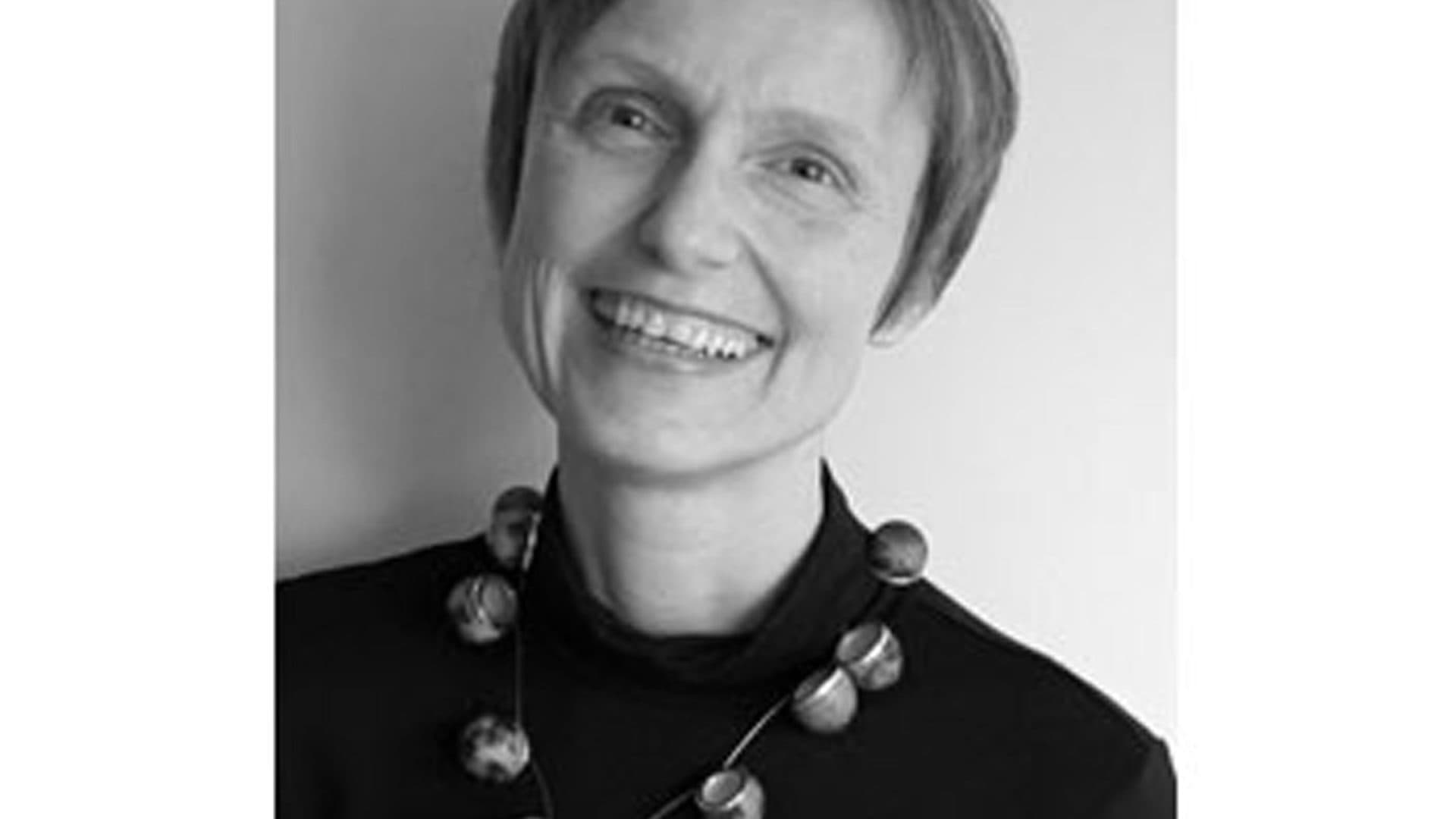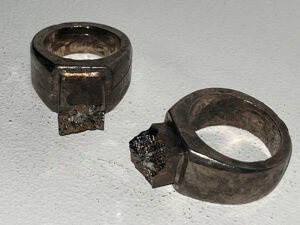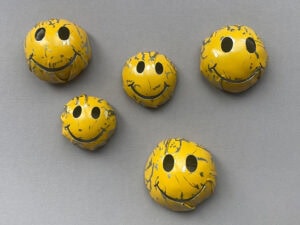In the wake of AJF Asia correspondent Anja Eichler’s profiles of Ubi Gallery and of professor Shannon Guo, we are happy to publish Eichler’s analysis of Professor Guo’s work. The author got access to the booming Chinese scene, and she is profiling for AJF those movers and shakers who are practically building it from the ground up—Teng Fei (Beijing), Shannon Guo (Shanghai), Wang Zhenghong (Hangzhou), to name a few. These educators, who are well aware of the Western definition of contemporary jewelry, are leading its re-interpretation along Eastern fault lines and proposing work that a Eurocentric frame of interpretation struggles to make sense of. Writing from Shanghai, Eichler shares with AJF readers the challenges facing her as she sits down to analyze Shannon Guo’s work.
Some time ago, when studying the menu in a restaurant in China, I stumbled over the dish “Griddle Incense Ass.” Having been living in China for two years by now, I know that Chinese and Western tastes differ quite a bit. Nevertheless, I also know that nobody here eats anybody’s ass. Hence, something obviously had been lost in translation.
One and the same character in Chinese can have several, sometimes totally unrelated, meanings, and its “true sense” is only revealed by its context. The reason for the menu’s mistranslation might be that “A” comes before “D” in our alphabet. The character 驴, which got translated into “ass,” also means “donkey.” The mix up might be the outcome of automated translation, which does not pay attention to the context of a single character. A human would translate the name of the dish into “Dry-pot good-smelling/savory donkey,” and on a Western menu, it might appear as “Dry Pot Donkey” (dry pot being a cooking technique).
Now, where is the link to jewelry? Just like language, I believe that contemporary jewelry could be seen as a means of communication. Some people want to see the cultural identity of the maker in the jewelry. At the same time, others claim that a work should speak for itself. But, is this truly possible if the cultural reference systems are as different as the Chinese and Western ones? What if we simply do not see the cultural identity in a piece because we lack the cultural background it refers to? What if it does not speak for itself because things get lost in translation? Is it necessary to understand the cultural background of a work, to know what is “in between,” or can it also be appreciated without it?
The following observations and thoughts related to Shannon Guo’s work are meant to illustrate both the challenges and the potential discoveries one can make when trying to go beyond the obvious.
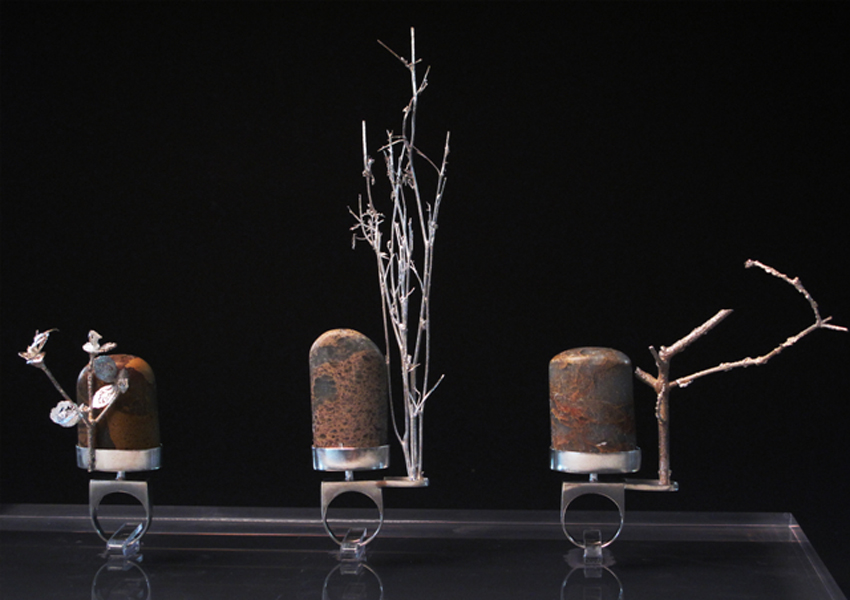
A Western View?
The first time I saw the three rings of the mini landscape ring series (景系列), I thought that they were a depiction of nature with no deeper meaning behind them. For me, even the title mini landscape ring series supported this perception. At the same time, I wondered how the weight of the ring would feel on my body when wearing it, how wearing it would affect me moving around, how it would affect people moving around me, and how all that would affect social interaction.
However, later on, I was told that the rings are made of Chinese seal stone and silver and refer to the Chinese tradition of Penjing (盆景), which significantly changed my way of looking at the pieces.

Penjing means “potted (or tray) landscape,” or “scenery in a container.” In Western countries, Penjing is often known in its Japanese version, the Bonsai. However, historically, Penjing had been in China for several hundred years before the Japanese took over the idea.
Since at least the first century AD, Daoist (or Taoist) mysticism has included the recreating of magical sites in miniature to focus and increase the properties found in the full size sites. For example, by recreating a mountain on a reduced scale, a devotee could focus on its magical properties and gain access to them. Through this practice, man’s soul was united with nature and its spirits. This philosophy is widely used in Chinese gardening. Creating the Penjing, a potted landscape, allowed the natural scenery to be moved indoors and thus closer to people. It was believed that the smaller the reproduction was in comparison to the original, the more magically potent it was likely to be. Penjing sceneries are often referred to as living sculptures or as three-dimensional poetry, which underlines its status as an art form.[1]
I believe that relating Penjing to Shannon Guo’s mini landscape series is important, but she did not give any explanations about how to “read” this relationship. Therefore, all of the following observations, associations, and interpretations are based on my subjective approach. But then to appreciate another person’s garden, the “key factor,” in its most literal sense, is getting the “key” to the garden’s gate. Once inside, whether you follow the path of its owner, is not.
Mini Landscapes in Perspective
Each of the rings has two elements, the depiction of the plant and the one of the rock. In the following, I will omit the phrase “depiction of” and just talk about “plant” and “rock” for convenience. I will start with some general observations before going into detail for each of the three rings.
The rock is actually a seal stone. Seals were employed in governmental systems. They represented authority and power. Later on, offices, families, and individuals also used them. Besides this, it is important to evaluate the depiction of the rock in relation to the one of the plant since this is a central feature of the philosophy behind Penjing.

In the following, I will explore each of the rings in detail, using the three aforementioned criteria: the “characters” of the plant and the rock as well as their relation to each other.
The Ring on the Left
This plant is the “neatest” one in the series. It is the only one that has leaves. Its main twig nestles up to the rock and only surmounts it by a tiny bit. Also, the stone is the most beautiful of the series with warm and saturated colors and harmonious proportions. The pattern on the stone seems to be mirrored by the shape of the plant. Whereas the plants of the other two rings are set off from their rocks, this one is directly attached to the stone’s setting.
The overall impression of plant and rock could be one of perfect harmony in the sense of adaption, if there was not an “obstinate sprout” sticking out from the plant. While the stone seems to be inanimate and static, the plant is animate and dynamic, however without overpowering the stone.

The plant on the ring has a shrub-like character. It looks like a plant aching to get to the light, one that does not have the time to solidify its growth but stays thin and brittle because it needs all its energy to outgrow everything else around it. It does not have any leaves, either because it is a plant in winter or because it is already dried-up. In any case, the plant does not look healthy. Also, the rock looks out of proportion. It looks too tall, and in comparison to its “neighbor” on the ring to the left, its colors look unsaturated and pale. Moreover, its tip is uneven. All in all, the stone looks unbalanced, as does the whole composition of stone and plant. The relation between stone and plant is one of dominance and subordination. The plant overpowers the stone. However, this dominance seems questionable and precarious.
The Ring on the Right
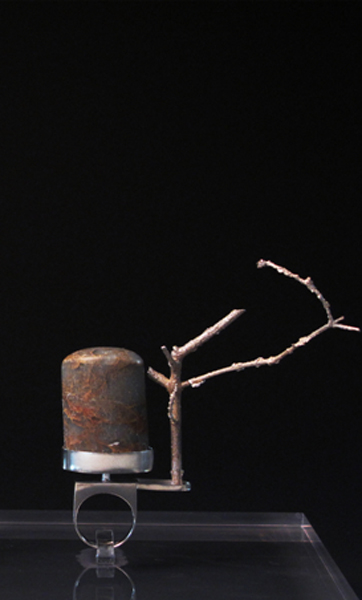
The earliest collected and then potted trees are believed to have been peculiarly shaped and twisted specimens from the wilds. These were “sacred” as opposed to “profane” because the trees could not be used for any practical, ordinary purposes, such as lumber. Their grotesque forms were reminiscent of yoga-type postures, which repeatedly bent back on themselves, recirculating vital fluids and said to be the cause of long life.[3]
On second glance, it becomes clear that most of the peculiar shape is manmade. The tree is pruned. The tree would have grown much more into the width, and thus distant from the rock, if it had not been pruned. Also, the sprout growing toward the rock and pressing against it was cut off. Only the sprout retracting toward the rock, or bent back on itself, and recirculating its vital fluids has been left intact. The tree does not have any leaves, but it seems to have some buds from which new sprouts might grow soon. The stone is of deeper color than the one in the middle. Its pattern is as branched as the tree next to it. The stone looks “confused.” In a way, it mirrors the character of the tree, which also seems to be confused, though not by nature but by human intervention. Moreover, the width of the stone appears to stay in correspondence to that of the tree. It is the widest of the three stones in the series and even seems a bit too wide.
The massive stone seems to dominate the tree. Nature was shaped according to man’s intentions. Compactness encounters fragility, and wholeness faces mutilation.
The Nature beyond Nature
Nature is a popular motif in jewelry both in China and the West. I believe that the most common Western reason for seeking guidance in nature for creating jewelry is nature’s inherent beauty, which predisposes it to become a model for designing decorations for the body. Karl Blossfeldt, for example, took photos of plants in order to use them as teaching material at art schools that later got published as books (for example, Art Forms of Nature). Besides this, he was a designer of floral jewelry himself. Also, Antoni Gaudi studied the forms of nature thoroughly, searching for a way to express these forms in a new architectural style.
In China, however, using natural motifs often goes way beyond that. Shannon’s ring series, for example, does not so much imitate nature, as it portrays a constructed version of it in order to serve a specific metaphorical agenda. Thus, her work points to forces such as dominance/subordination, static/dynamic, and potency/fragility. These relationships are found in nature as well as in human societies or relationships between people. Like yin and yang, these are seemingly opposite forces, which are interconnected in the natural world. They give rise to each other as they interrelate, and in this sense, are complementary rather than opposing.
There are numerous ways of interpreting Shannon’s work. For example, since the stone is a seal stone, it could be interpreted as government while the plant represents the people. Other interpretations, such as society/individual, male/female, or any other duality, are imaginable as well. This, however, is beside the point of this essay.
Without having done the research about Penjing and its philosophical implications, Shannon’s work would have fallen short of its message for me. Her work looks different from Western depictions of nature, however not so much as to point me to its origin as Chinese, and not at all to its reference to Penjing or Daoism. Generalizing this impression, I wonder whether an observer is only able to detect cultural identity in a work if it is reduced to familiar clichés. Does it need a dragon to register as Chinese?
Just like the alleged “Griddle Incense Ass” turned out to be of a dish of a different kind, jewelry from a different culture might bear another meaning than we thought based on our cultural reference system. Trying to bridge cultures and to understand the meaning behind what is said takes time, effort, and will. At the same time, it is immensely enriching. This holds true in dealing with issues of jewelry as well as language.
With the rise of Chinese contemporary jewelry, Western audiences may want to be cautious about how they tend to interpret some of the pieces shown in international exhibitions. It may also require some humbleness by accepting that we do not know a lot about Chinese culture, philosophy, and history, which are important keys to deciphering some of the potential meaning behind a contemporary jewelry piece.
[1] History of Bonsais, Robert J. Baran, www.Bonsaiempire.com/origin/Bonsai-history
[2] Penjing: The Chinese Art of Bonsai. Zhao Qingquan, 2012. Shanghai Press and Publishing Development Company. p. 11, excerpt from Wikipedia http://en.wikipedia.org/wiki/Penjing
[3] History of Bonsais, Robert J. Baran, www.Bonsaiempire.com/origin/Bonsai-history
